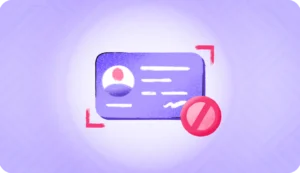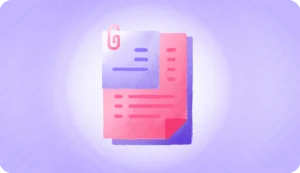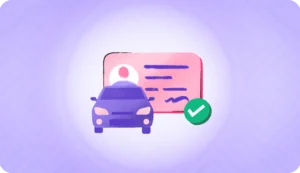Writing and document creation have always been susceptible to forgery. Laws against document falsification date back to 80 BC when Romans banned such acts to stop illegal property transfers. The challenge, however, has persisted through the ages.
Fast forward to today, and document forgery is still a significant white-collar crime. It typically involves altering real documents or crafting a counterfeit one. A common example is signing someone else’s name to deceive others.
Businesses face severe risks: financial losses from fraudulent transactions, reputational damage breach of customer trust, and even legal repercussions Consequently, businesses—online and offline—need to implement effective identity verification systems. To prevent document fraud while still providing a smooth customer experience. In this blog, we explore in detail what document forgery is and how you can safeguard your business from the same.
What is document forgery?
Document forgery falls under the umbrella of document fraud, where genuine documents are altered without permission. The intent is often financial gain, identity theft, or evasion of legal responsibilities.
While both fake documents and forgery have similar intentions, their methods differ. A fake document simply tries to imitate a real one, but forgery involves taking authentic documents and modifying them. For example, forgery might include using another’s signature to make a document look valid.
Passports and driver’s licenses are among the most frequently forged documents. Some minors even resort to using fake IDs to access age-restricted services, like purchasing alcohol on e-commerce sites.
Millennials aged 30-39 are the most frequent victims of identity theft. Surprisingly, there have also been numerous cases where loans and credit lines are taken out in the names of 8-year-olds, leading to annual losses of around $1 billion for families.
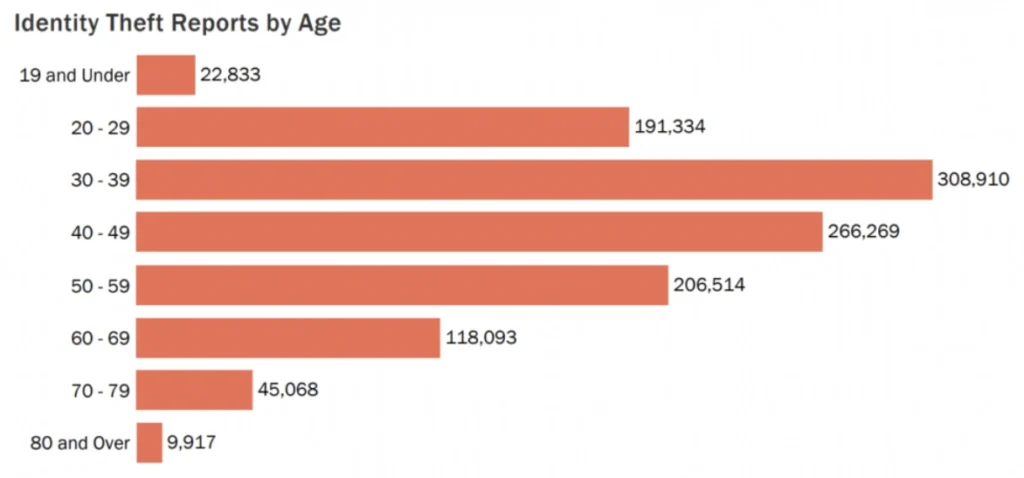
Image Source: IdentityTheft.org
Here are some additional statistics that might surprise you:
- Americans face a 50% higher likelihood of identity theft, with rates doubling the global average
- Victims experience out-of-pocket losses totaling around $1.7 billion
- Individuals with social media accounts are 46% more susceptible to becoming victims of identity theft
Different types of document forgery
Documents can be forged in various ways, and recognizing these methods helps identify potential fraud. Below are some of the most popular types:
1. Creating counterfeit documents
One common method is producing counterfeit versions of legitimate documents. These counterfeit documents replicate an official document as closely as possible, often mimicking security features like holograms, watermarks, or security threads. Specialized tools and techniques are typically used to achieve this level of accuracy.
Passports, identity cards, foreign currencies, and legal papers with official seals are the most frequently counterfeited documents.
2. Manual forgeries
Manual forgery involves physically altering information on an existing document. This could mean erasing text, using correction fluid, or cutting and pasting sections to modify content.
The changes might be subtle, but they can completely distort the document’s original intent.
3. Electronic manipulation
Digital forgeries are becoming more common due to advanced software tools. Fraudsters can alter scanned documents or even create new ones from scratch using programs like Photoshop. Because these alterations are done electronically, they can be harder to detect. Examples include fake driver’s licenses, altered passports, and tampered digital signatures.
4. Document assembly
This technique is similar to creating a collage. It involves combining pieces of legitimate documents to form a fraudulent one. It can be done physically—by cutting and pasting materials—or digitally, by merging scanned document elements. The result is a new document that appears authentic but is entirely fraudulent.
5. Blank stealing
Blank stealing involves taking blank forms of official documents, such as certificates, checks, or letterheads, and filling them out with false information.
Since the blank forms are genuine, the forged documents seem legitimate at first glance. The forgery works because the document’s format is genuine, even though the information is not.
How document forgery is achieved
Document forgery can be achieved through various techniques. Signature forgery is one of the most prevalent methods.
Another common practice is creating fake IDs. Forgers often use real ID templates and modify personal details, allowing someone to impersonate another individual.
These forgeries can be used for various illegal activities, from opening bank accounts to accessing restricted services.
Why do fraudsters create counterfeit documents?
Fraudsters create counterfeit documents for various reasons, such as identity theft, fraud, and money laundering.
- Identity Theft: Fraudsters use fake IDs, passports, or other personal documents to impersonate individuals, open fraudulent accounts, or gain access to services. In 2021 alone, the U.S. Federal Trade Commission (FTC) received 1.4 million identity theft reports. Financial losses linked to identity theft were estimated at $10.2 billion, with the median loss per case at around $500.
- Fraud: Counterfeit documents also significantly influence financial and insurance fraud. For instance, insurance fraud costs the U.S. $308.6 billion annually. Fraudsters may falsify medical records, invoices, or accident reports to claim illegitimate insurance payouts
- Money Laundering: Scammers create fake financial documents to launder money through legitimate businesses or financial institutions, masking the origins of illegally obtained funds. This type of document manipulation can involve altering invoices or bank statements to hide transactions or create false business records, helping criminals move money undetected
A 2022 study revealed a 24% rise in ID document forgery compared to the previous year. This increase highlights just how prevalent the issue has become, making it clear that more robust measures are urgently needed to tackle document forgery.
Penalties for forged documents
Document forgery penalties differ widely across regions, and the legal and monetary consequences are often severe due to the potential harm these crimes cause. Here’s a detailed look at the penalties for document forgery, including relevant articles from various countries:
1. United States
In the U.S., document forgery can be prosecuted under multiple laws, with penalties depending on the nature of the forgery.
Title 18, U.S. Code, Section 471 addresses counterfeiting, while Section 1028 covers creating or using false identity documents. Forging federal documents, such as immigration papers or Social Security cards, can result in a prison sentence of up to 15 years. Under Section 1344, crimes related to financial fraud may result in sentences of up to 20 years.
2. United Kingdom
Under the Forgery and Counterfeiting Act 1981, the UK treats document forgery as a severe crime. Section 6 of the act covers the creation, alteration, or use of forged documents. Depending on the document type and the context of the crime, the penalty for forgery can be imprisonment for up to 10 years.
Identity document forgery, such as passports or driver’s licenses, can attract harsher penalties, especially when used for fraudulent activities like identity theft.
3. Germany
Germany addresses document forgery under Section 267 of the German Criminal Code (Strafgesetzbuch – StGB). It includes the creation, alteration, or falsification of documents. Penalties range from fines to imprisonment for up to 5 years.
The penalties are much more severe if the forgery involves significant harm or is linked to organized crime.
4. France
In France, document forgery is prosecuted under the Penal Code (Code pénal), specifically Article 441-1. This article defines forgery as altering the truth of a document in a way that can harm others.
The penalties include fines and imprisonment, with sentences ranging from 5 to 10 years for public or legal documents. Forging passports, government certificates, or other official documents can result in more significant penalties, especially when used for fraud.
5. Canada
Canada’s Criminal Code deals with document forgery under Section 366, which broadly defines forgery as making false documents with the intent to defraud. This could include altering passports, checks, or government documents.
The maximum sentence for serious offenses can go up to 14 years. Specific provisions under Section 368 address using forged documents, which can lead to equally severe penalties.
6. Australia
In Australia, penalties for document forgery are covered under Section 144.1 of the Criminal Code Act 1995. Forging Commonwealth documents such as passports or visas can lead to a maximum penalty of 10 years imprisonment.
Forgeries linked to financial institutions or those used in fraud cases may also carry severe penalties, depending on the scope and damage caused.
7. Japan
Japan’s Penal Code addresses document forgery in several articles, such as Article 159 for private documents and Article 158 for official documents.
Forging private documents may lead to imprisonment for up to 5 years, while forgery of public or official documents can carry a maximum sentence of up to 10 years, especially if it involves passports, government certificates, or identity documents
8. India
India’s Indian Penal Code (IPC), under Sections 463-471, deals with forgery and the use of forged documents. For example:
| IPC Section | Crime | Punishment |
| 463 | Forgery | Up to 2 years in prison, fine, or both |
| 464 | Creating false documents | |
| 466 | Forgery of record of court or of public register | Imprisonment up to 7 years, and/or fine. |
| 467 | Forging valuable documents, such as wills or property papers | Up to 10 years in prison or life, fine, or both |
| 468 | Forgery for cheating | Up to 7 years in prison, fine, or both |
| 471 | Using a forged document | Up to 7 years in prison, fine, or both |
Forgery involving government documents or official IDs can attract harsher penalties.
How to identify forged documents?
Identifying forged documents requires both keen observation and advanced techniques. Let’s break down some practical ways to identify such documents—
1. Comparing signatures to known originals
One of the easiest ways to detect a forged document is by comparing signatures to authentic samples. Signatures are often imitated but can reveal subtle inconsistencies.
For example, in a famous case involving Frank Abagnale, a notorious forger and con artistsuccessfully forged $2.5 million in checks by replicating signatures. However, banks eventually noticed minute differences between the genuine signatures and his versions—-shaky lines and or unusual pressure points, leading to his arrest. In that time, he had successfully cashed over 17,000 counterfeit checks in 26 countries.
In recent cases, criminals have also attempted identity spoofing by forging signatures on official documents like checks or contracts to gain access to financial resources. To catch such discrepancies, law enforcement and forensic document examiners compare the suspect’s signature with previously authenticated documents.
2. Analyzing writing style and inconsistencies
Handwriting analysis remains a powerful tool in identifying document forgery. For example, forensic experts analyze letter formations, pressure points, and writing flow to determine authenticity.
This method is also effective in detecting deepfakes and image injections. Forensic experts may detect pixel-level inconsistencies that reveal tampering when text is digitally altered, especially when comparing digital handwriting with scanned copies.
3. Considering the context of the document
Fraudsters often create forged documents that don’t fit the situation, raising red flags. For instance, Investigators may uncover fraud in immigration papers by noticing mismatched dates or inconsistencies with the applicant’s timeline.
This method also applies to financial forgeries, where mismatched company logos, outdated forms, or irrelevant signatures can signal tampering.
Documents that rely on identity spoofing also tend to show a lack of understanding of the original context. For example, a fake government ID might miss specific security features, like microprinting or holograms, leading to its detection during verification.
4. Seeking professional expertise from forensic document examiners
Sometimes, the most effective way to confirm a forgery is by seeking professional help. Forensic document examiners use advanced tools like HyperVerge to analyze inks, paper fibers, and document structure. By using software that analyzes pixel patterns and image anomalies, experts can reveal alterations invisible to the naked eye.
For instance, a forensic document examination was instrumental in the investigation of the infamous Howard Hughes forged autobiography case, where the ink used to sign a contract was dated decades after the contract’s supposed creation
Combating document forgery
As document forgery becomes increasingly sophisticated, businesses and institutions must adopt robust, multi-layered strategies to counter it. This involves a combination of advanced technologies and rigorous security protocols designed to identify fraudulent documents and prevent them from causing harm.
1. Implementing robust identity verification processes
One of the most effective ways to combat document forgery is by implementing thorough identity verification processes.
Know Your Customer (KYC) and Anti-Money Laundering (AML) regulations have become standard practices across industries like banking and insurance. These processes require users to submit legitimate, verifiable documents to prove their identity and legal standing. For instance, financial institutions need individuals to submit personal IDs, proof of address, and financial history to verify authenticity.
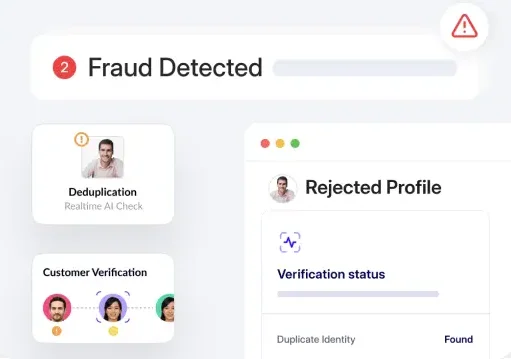
Enable proactive fraud detection and prevention using HyperVerge’s identity verification solution
HyperVerge, for instance, offers a robust AI-based identity verification solution that integrates digital KYC seamlessly into existing systems, making the entire process more efficient. This is complemented by AML screening software, which is essential for identifying financial crime risks by scanning data against global watchlists and sanctions databases.
Integrating AI and machine learning in AML screening further strengthens this process, allowing it to adapt to new threats and regulatory changes in real time.
2. Utilizing digital document verification solutions
Technology has transformed the way organizations fight document forgery. Using digital document verification solutions, businesses today can instantly verify the authenticity of documents. These tools can scan passports, driver’s licenses, or any official document and detect anomalies such as manipulated images, improper fonts, or mismatched signatures.
HyperVerge specializes in real-time document verification and facial recognition to combat document forgery. The system is designed to detect fraud by analyzing photos, documents, and videos through machine learning algorithms. It checks for deepfakes and image injections, making it a strong tool against forgery attempts.
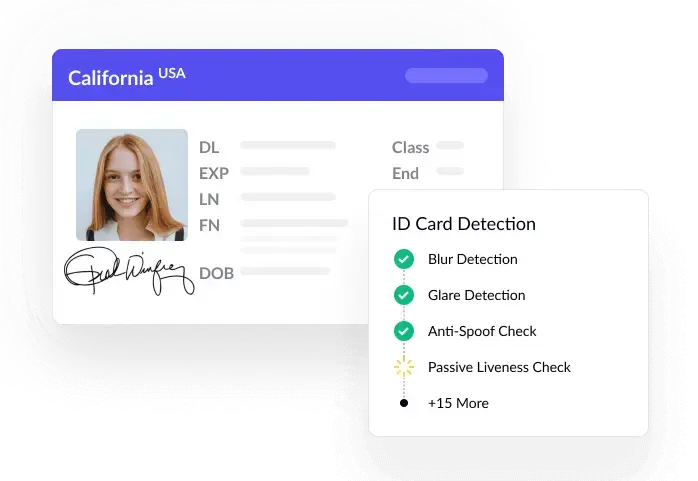
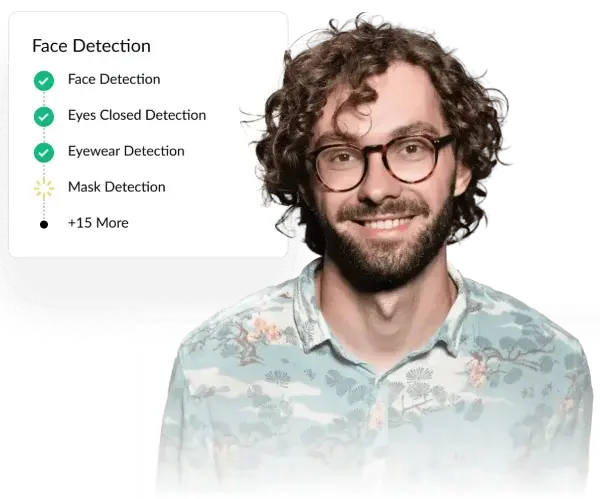
Ensure secure and accurate identity verification on different facial variations
By automatically matching document details with an individual’s facial data and checking for tampered photos, HyperVerge ensures that only legitimate documents pass verification.
Additionally, the platform’s face recognition API includes advanced AI-driven features such as:
- Deepfake detection
- Face de-duplication
- Forgery checks
- Biometric verification
- Liveness checks
- Active liveness detection
Backed by 13 years of AI development, the AI face recognition system boasts an auto-approval rate of over 95% and can authenticate faces in just 0.2 seconds. The accuracy of HyperVerge’s passive liveness detection method has been certified by iBeta.
HyperVerge has been deployed in various sectors, including financial services, to prevent fraud in account openings, loan applications, and KYC processes.
3. Employing advanced security measures
A critical line of defense against document forgery is incorporating advanced security features into the document verification process.
Multi-factor authentication (MFA), for instance, requires multiple steps to confirm a user’s identity, making it harder for fraudsters to forge or bypass verification processes. By combining something the user knows (like a password) with something they have (like a verified document or mobile device), MFA reduces the chances of successful forgery.
Additionally, encryption plays a crucial role in protecting sensitive information. By encrypting digital documents, organizations ensure that only authorized personnel can access and modify the information
This protects against unauthorized changes to digital documents and forged records from being submitted.
4. Educating employees on forgery risks and detection methods
No amount of technological defense can fully replace the importance of human vigilance. Employee education is vital to combating document forgery. Training staff to recognize common forgery tacticslike mismatched fonts, altered signatures, and fake sealscan be a frontline defense.
Institutions that regularly handle sensitive documents, such as banks and legal firms, must conduct regular workshops on detecting document fraud. These sessions can highlight both traditional forgeries and new digital threats like identity spoofing and help employees prepare for the same.
Advanced security technologies for preventing forgery
Here are some more advanced technologies that help safeguard against fraudulent activities.
1. Biometric signature verification
Biometric signature verification analyzes unique handwriting traits, such as pressure and speed, alongside visual appearance. This enhances security by comparing real-time signatures with stored profiles, making it harder for forgers to succeed, particularly in banking and legal sectors where authenticity is crucial.
2. Digital signature technology
Digital signatures use cryptographic methods to secure electronic documents, ensuring they cannot be altered post-signature. They authenticate signers and comply with legal standards like the eIDAS regulation and ESIGN Act, making them essential for organizations prioritizing preventing forgery in digital communications.
3. Blockchain-based authentication
Blockchain-based authentication leverages decentralized ledgers to create tamper-proof records of transactions and documents. By storing signatures and important documents on a blockchain, organizations can ensure tamper-proof records.
Blockchain’s immutability makes it ideal for legal, financial, and governmental applications, where maintaining the integrity of documents and reducing fraud is critical.
4. Secure signature pads and devices
Secure signature pads and devices offer a practical solution for collecting and verifying signatures digitally in real time. These devices capture biometric data such as pressure, speed, and motion as the signature is made, creating a detailed and unique digital profile for each individual.
This biometric data adds a layer of security, ensuring that forged signatures are easily distinguishable from genuine ones.
5. Optical Character Recognition (OCR) for signature analysis
OCR technology enables the automated recognition and analysis of text and signatures within scanned documents. For signature verification, OCR systems compare a scanned signature against a database of known signatures to detect irregularities or forgeries.
This technology is often paired with AI-based algorithms that enhance its accuracy by recognizing subtle variations in the signature’s strokes or pressure.
With an AI/ML-backed OCR solution like HyperVerge’s, adapting to new regions is extremely easy. HyperVerge can recognize characters in over 150 languages and supports nearly half a million fonts worldwide. It also excels at extracting details from documents, even under challenging conditions like low resolution or poor contrast.
Protect your business from forged documents with HyperVerge
Document forgery poses a serious threat to organizations and businesses globally and the stakes are higher than ever. Thankfully, technology has stepped up to tackle these challenges head-on.
At the forefront of this fight is HyperVerge. With cutting-edge technology and a commitment to staying ahead of fraud trends, HyperVerge helps organizations detect and prevent forgery with unparalleled accuracy. Their solutions like automated document verification and AI-powered liveness detection empower businesses to safeguard operations, protect sensitive data, and build trust with customers
Sign up for free today to learn more!
FAQs
1. What counts as document forgery?
Document forgery refers to the act of creating, altering, or using a document with the intent to deceive. This can include falsifying signatures, creating counterfeit documents, or modifying existing documents to misrepresent information.
2. What is the most commonly forged document?
Identity cards and driver’s licenses are the most commonly forged documents, primarily because they are frequently used for age verification and identification purposes. Other frequently forged documents are passports, financial documents, and academic credentials.
3. What are the consequences of document forgery?
The consequences of document forgery can be severe and vary by jurisdiction. Penalties may include hefty fines, imprisonment, or both. For instance, in the U.S., federal penalties for forgery can reach up to 20 years in prison. The reputational damage from a forgery conviction can also have long-lasting effects on personal and professional relationships.



